Understanding Local Beach Conditions
The coastline of Cornwall, England is renowned for its stunning beaches and diverse coastal landscapes. The geography of Cornwall is characterized by a mix of sandy shores and rocky outcrops, offering a variety of beach experiences. Sandy beaches like Fistral Beach and Watergate Bay are popular among surfers and sunbathers, while rocky beaches such as Bedruthan Steps provide picturesque views and intriguing tidal pools.
Weather patterns in Cornwall are notably influenced by its maritime climate, with mild winters and cool summers. However, coastal conditions can change rapidly, and it is essential to stay informed about the local weather forecasts. Wind and wave conditions can vary significantly, impacting the safety and enjoyment of beach activities. High winds can create powerful waves, beneficial for experienced surfers but potentially hazardous for novices and swimmers.
Tides play a crucial role in shaping beach conditions in Cornwall. The region experiences significant tidal variations, with spring tides bringing the highest and lowest levels of water. These tides can drastically transform the beach landscape, exposing hidden rocks and creating strong currents. It is vital for beachgoers and surfers to be aware of the tide schedules to avoid getting caught in dangerous situations, such as being stranded on rocks or swept away by rip currents.
Local wildlife also contributes to the unique beach conditions in Cornwall. Beachgoers and surfers should remain vigilant for jellyfish, particularly during warmer months when jellyfish blooms are more common. While most jellyfish in Cornwall are harmless, some species can cause painful stings. Additionally, seals are frequently spotted along the coastline. While they are generally non-aggressive, it is advisable to maintain a respectful distance to avoid disturbing them and to ensure personal safety.
Understanding the distinctive beach conditions in Cornwall is essential for a safe and enjoyable coastal experience. By being mindful of the geography, weather patterns, tides, and local wildlife, visitors can make the most of their time on Cornwall’s beautiful beaches while minimizing risks.
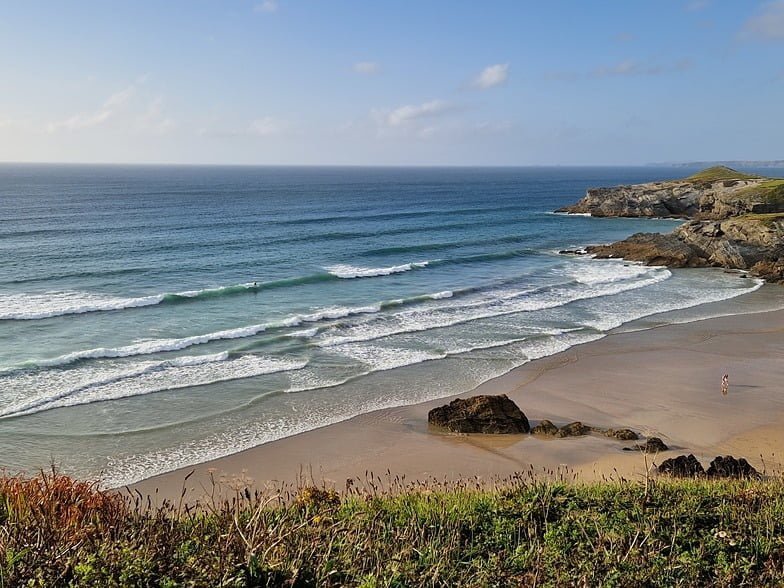
Understanding Beach Flags and Signs
When visiting the beach, it is crucial to understand and adhere to the various flags and signs displayed, as they provide essential information about the current conditions and potential hazards. These indicators are designed to ensure the safety of all beachgoers, and being familiar with them can significantly reduce the risk of accidents and injuries.
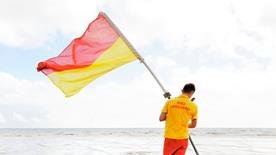
Lifeguard-patrolled swimming and body boarding zone or lifeguard on duty.
This shows the lifeguarded area and is the safest place to swim and bodyboard.
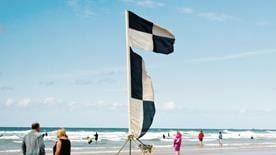
Surfboard and other water craft zone or zone boundary.
For surfboards, stand-up paddleboards, kayaks and other non-powered craft. Launch and recovery area for kitesurfers and windsurfers. Never swim or bodyboard here.
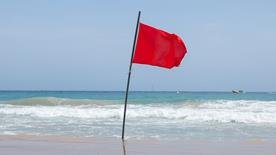
Dangerous conditions: do not enter the water.
Signifies a severe hazard, that water conditions are unsafe for swimming and other water activities, and people should not enter the water.
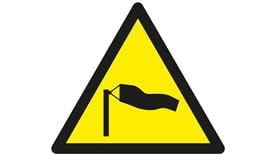
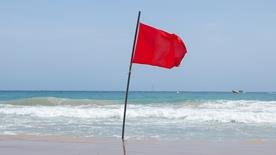
A prohibition sign is used to tell you that an activity is forbidden, for your safety. There may be different symbols inside it depending on what activity is forbidden – for example, swimming, surfing or fishing.
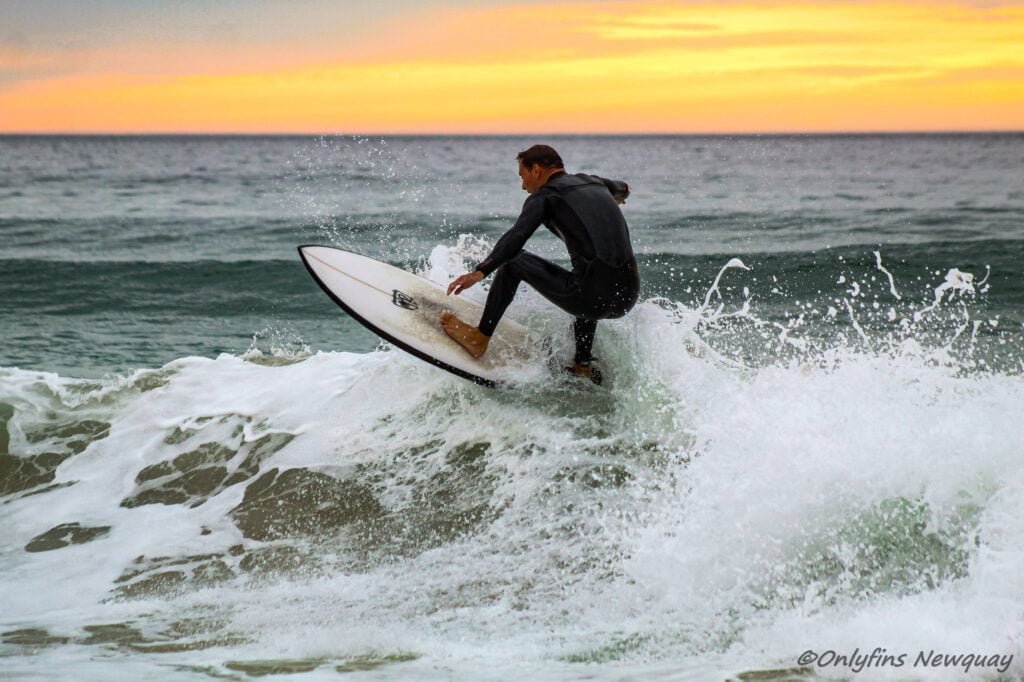
Essential Surfing Safety Tips
When it comes to surfing in Cornwall, prioritizing safety is paramount. Selecting the right surf spot is crucial, especially for beginners. Cornwall offers a variety of beaches, each with differing wave conditions. It’s advisable to choose a beach that matches your skill level; novice surfers should seek out beaches with smaller, gentler waves, while more experienced surfers can explore spots with larger, more challenging surf.
Equally important is the practice of checking surf reports and weather conditions before heading out. Surf reports provide vital information on wave height, tide times, and wind direction, all of which significantly impact surfing conditions. Additionally, understanding the weather forecast can help you avoid potentially dangerous situations, such as sudden storms or high winds, which can make the sea unpredictable and hazardous.
Appropriate gear is another critical component of surfing safety. Wetsuits are essential in Cornwall’s often chilly waters, providing both thermal insulation and buoyancy. A well-fitted wetsuit can make a significant difference in maintaining body temperature and energy levels. Moreover, always use a leash to keep your surfboard attached to you. This simple piece of equipment ensures you don’t lose your board in the waves, which can be both a safety hazard and an inconvenience.
Understanding rip currents and how to escape them is a must for any surfer. Rip currents are powerful, narrow channels of fast-moving water that can quickly pull swimmers and surfers out to sea. If caught in a rip current, the key is to remain calm and avoid swimming directly against it. Instead, swim parallel to the shore until you are out of the current, then make your way back to the beach.
Lastly, practicing proper surfing etiquette is essential to prevent collisions and injuries. This includes not dropping in on another surfer’s wave, waiting your turn, and being aware of your surroundings at all times. By respecting these unwritten rules, you not only ensure your own safety but also contribute to a harmonious and enjoyable surfing environment for everyone.
Essential Surfing Safety Tips
When it comes to surfing in Cornwall, prioritizing safety is paramount. Selecting the right surf spot is crucial, especially for beginners. Cornwall offers a variety of beaches, each with differing wave conditions. It’s advisable to choose a beach that matches your skill level; novice surfers should seek out beaches with smaller, gentler waves, while more experienced surfers can explore spots with larger, more challenging surf.
Equally important is the practice of checking surf reports and weather conditions before heading out. Surf reports provide vital information on wave height, tide times, and wind direction, all of which significantly impact surfing conditions. Additionally, understanding the weather forecast can help you avoid potentially dangerous situations, such as sudden storms or high winds, which can make the sea unpredictable and hazardous.
Appropriate gear is another critical component of surfing safety. Wetsuits are essential in Cornwall’s often chilly waters, providing both thermal insulation and buoyancy. A well-fitted wetsuit can make a significant difference in maintaining body temperature and energy levels. Moreover, always use a leash to keep your surfboard attached to you. This simple piece of equipment ensures you don’t lose your board in the waves, which can be both a safety hazard and an inconvenience.
Understanding rip currents and how to escape them is a must for any surfer. Rip currents are powerful, narrow channels of fast-moving water that can quickly pull swimmers and surfers out to sea. If caught in a rip current, the key is to remain calm and avoid swimming directly against it. Instead, swim parallel to the shore until you are out of the current, then make your way back to the beach.
Lastly, practicing proper surfing etiquette is essential to prevent collisions and injuries. This includes not dropping in on another surfer’s wave, waiting your turn, and being aware of your surroundings at all times. By respecting these unwritten rules, you not only ensure your own safety but also contribute to a harmonious and enjoyable surfing environment for everyone.
Beach Safety for Families and Non-Surfers
Ensuring a safe and enjoyable beach experience for families and non-surfers in Cornwall requires awareness and adherence to several crucial safety guidelines. One of the fundamental rules is to always swim in designated areas supervised by lifeguards. These zones are clearly marked and regularly patrolled, providing a safer environment for swimming and paddling. Lifeguards are trained to respond quickly to emergencies, offering an added layer of security.
Understanding beach flags and their meanings is another essential aspect of beach safety. Beach flags indicate the safety of the water conditions. For instance, a red flag signifies danger, and swimming is strictly prohibited. Meanwhile, a yellow flag denotes moderate conditions where swimming is allowed but with caution. A green flag indicates calm waters, safe for swimming, and a black and white checkered flag marks areas for surfing only, where swimming is not permitted. Familiarizing yourself with these flags can prevent accidents and ensure a safer beach visit.
Staying hydrated and protecting oneself from the sun are also vital. The coastal environment can cause rapid dehydration, so it’s crucial to drink plenty of water throughout the day. Additionally, applying a broad-spectrum sunscreen with a high SPF, wearing hats, and using beach umbrellas can protect against harmful UV rays. Sunburn can occur quickly, especially on overcast days when UV rays penetrate through clouds.
Basic first aid knowledge is invaluable for addressing common beach injuries such as cuts, scrapes, and sunburns. For minor cuts and scrapes, it’s important to clean the wound with fresh water to remove any sand or debris and then apply an antiseptic. Covering the wound with a sterile bandage can prevent infection. For sunburns, cool compresses, aloe vera gel, and over-the-counter pain relief can alleviate discomfort. In case of severe sunburn or any serious injury, seeking medical attention promptly is recommended.
By following these safety tips, families and non-surfers can enjoy Cornwall’s beautiful beaches with peace of mind, ensuring a fun and safe beach outing for everyone.
Emergency Procedures and Local Resources
In the event of an emergency while surfing or enjoying the beach in Cornwall, it is crucial to prioritize safety and follow proper procedures. If someone appears to be in distress in the water, the first step is to alert the nearest lifeguard. Lifeguards in Cornwall are highly trained and equipped to handle water rescues and other emergencies. They can be identified by their red and yellow uniforms and are usually stationed at strategic points along the beach.
It is important to avoid attempting a rescue if you are not trained. Untrained rescuers can put themselves and the person in distress at greater risk. Instead, signal for help by waving your arms and shouting to attract the attention of lifeguards or other bystanders. If no lifeguards are present, call emergency services immediately. The emergency contact number in the UK is 999, and you should clearly state your location and the nature of the emergency.
For any medical emergencies, knowing the locations of nearby hospitals is essential. In Cornwall, the Royal Cornwall Hospital in Truro and the West Cornwall Hospital in Penzance are some of the key medical facilities equipped to handle emergencies. Having the contact numbers for these hospitals can be a lifesaver in critical situations.
For those looking to enhance their surfing and beach safety skills, numerous local surf schools and organizations offer training and courses. Institutions such as the Fistral Beach Surf School and the Cornwall Surf Academy provide comprehensive safety training, including water rescue techniques and first aid. Engaging in these courses can significantly improve your confidence and preparedness for any potential emergencies while enjoying the beautiful beaches of Cornwall.
By following these emergency procedures and utilizing local resources, visitors and residents alike can ensure a safer and more enjoyable experience on the beaches of Cornwall.